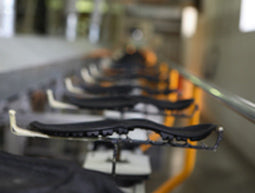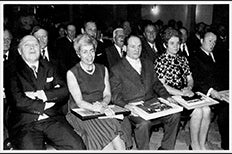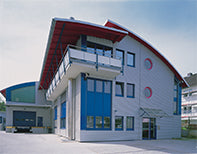About LOWA
QUALITY IS NOT A COINCIDENCE
TRADITION AND INNOVATION SINCE 1923
With almost 100 years of bootmaking experience, it's no wonder that LOWA's quality is not a coincidence.
Made in Europe and crafted to perfection, LOWA uses only the highest quality materials to create boots that you can use on any terrain and in any weather.
From specially selected cowhides in Europe to using iconic licensed brands like Gore-Tex®, LOWA ensures each boot is designed to last.
This makes our manufacturing process and the boots themselves incredibly sustainable for the future.
Learn more about the quality and workmanship of LOWA boots below.
BOOT CRAFTMANSHIP
Leather
The most important material in the manufacturing of footwear, leather, is made stable and long-lasting by tanning. Leather is very durable and abrasion resistant, while also being flexible, somewhat elastic, and able to maintain its shape despite bending and flexing. Plus, depending on its treatment, it can absorb varying amounts of water vapour. In addition, it can be made waterproof during the tanning process through a special impregnation, the so-called hydrophobic treatment.
The tanning agents are bonded firmly to the fibres of our high-quality leathers. Our tanneries produce their leathers as environmentally responsibly as possible, and each runs its own wastewater treatment plants.
LOWA uses only specially selected cow hides from Europe. These are of course free of pollutants.
Types of Leather
Based on their desired uses, leathers are differentiated in many ways, for example:
- Smooth leather - Upper layers of the hide, not as scratch resistant.
- Nubuck leather - Upper layers of the hide, lightly sanded, moderately scratch resistant and stable, ideal for trekking boots.
- Suede leather or split leather - Middle layers of the hide, visible grain, very durable, limited stretch and less resistant to tears.
- "Roughout" ("Hunting") leather - Very durable surface with a stable backside, optimal for Alpine boots.
Cowhides in an unfinished state are approximately 6 to 8 mm thick and must, therefore, be split. During the tanning process, it's decided where the splitting will occur - whether it will be thicker full-grain leather and a thinner split-leather or vice-versa.
Punching Pattern
Very similar to what happens in baking biscuits, a press - hydraulic in this case - punches a pattern-cutter through the leather. A pattern-cutter is necessary for every piece of the footwear, and of course also for each piece for each shoe and boot size. What’s vital to the quality of the footwear is where the pattern-cutter is placed on the varying leather types based on their structure and flexibility.

Sewing
After the leather pieces are punched out, they must be precisely sewn together with robust sewing machines. The seams of a GORE-TEX® lining must also be taped tightly shut after the pieces are sewn together.

Gluing and Fixing
At LOWA, an exclusive spot-gluing process guarantees that the material's pores for transporting moisture out of the footwear remain open. Fixing the various metal eyelets and hooks is done with a specialised riveting machine.

Lasting
A last is what one calls the foot-shaped forms made of wood or plastic on which a shoe is made. The shoe (or the uppers) is literally shaped over the last in order to achieve the use of company-specific features in the shoe or boot that are hallmarks of the fit and feel.
For every type of footwear, there is a special last that is designed for specific demands and expectations. Women’s footwear styles, of course, have their own special LOWA lasts.

Shaping the Uppers
Shaping the uppers (the top part of the shoe or boot) is the difficult process of forming the shape of the leather and then attaching it to the last. These days, heavy, computerised machinery guides the process of drawing the leather upper over the last until it is firmly and properly positioned.Then the lasting machine’s pincers pull the bottom edge of the upper fully underneath the form, allowing the upper to be fastened using cement or tacks on an insole that’s been placed on the last. The outsole will be attached later to this same insole – the characteristics of which vary according to whether the shoe or boot is meant to be flexible or stiff.

Rubber Rand
A typical quality hallmark of LOWA is the rubber protective edging, or "rand", that is mounted separately. This rubber strip that runs around the footwear protects the leather from moisture and damage.

Soles
LOWA almost exclusively uses rubber soles which are usually equipped with a cushioning midsole of polyurethane (PU) foam and frequently with TPU stabilising elements. Not only the underside of the shaped and cemented upper but also the sole must be extensively pre-treated before they can be cemented together with a pneumatic press. Immediately after attachment, the bonding is accelerated by curing in a cooling chamber.

Removal of the Last
The last, which has given shape to the product during production, is then pulled out of the finished footwear. Until several years ago, this difficult task was still done by hand. Today, heavy-duty machinery completes the job.

Finishing
During the final quality control, all footwear gets a finishing touch. Then laces are threaded, foot-beds inserted, and product tags, etc. attached before the footwear is packed in a box.

Packing and Shipping
Footwear is stored in the LOWA warehouse and sent to customers from there.

DIN ISO Certification
Quality and continuity really do pay off! LOWA has proved this yet again with its successful DIN EN ISO 9001:2008 certification renewal for mountain and trekking footwear.
The certification quality control encompasses the areas of development, production, and sales. On top of this, there is an audit of the business and social responsibility, which is carried out by the Footwear Industry Research and Inspection Institute.

HISTORY
1920 - 1930
1923
Foundation of LOWA by Lorenz Wagner
LOrenz WAgner founds LOWA in the Bavarian village of Jetzendorf near Munich, Germany. The story begins with the production of brogue oxfords. The high quality of the handwork in the Norwegian welt-stitched shoes—a manufacturing process that stemmed from the mountains—already required an expansion of the facility in the late 1920's.

1930/1931
The first manufacturing facility was built. The groundwork is laid for further success with Alpine boots for the mountain infantry as well as with lace-up ski boots. Sepp Lederer begins at the company as an apprentice.

1950 - 1960
1949/1950
During the Korean Conflict, the cost of materials leaps by 50%, and leather becomes the object of speculation. Just to be able to continue production, LOWA has to purchase highly priced materials.
As prices fall and bills come due, the operation becomes insolvent overnight.
1953
Lorenz Wagner passes away

1955
The second generation
The second generation steps forward: Wagner's daughter Berti and her husband Josep "Sepp" Lederer take over the company and expand the offerings step-by-step in the same direction as the founder.

1970 - 1980
1970
New Technologies
The rapid introduction of man-made materials sends clear messages of innovation. One of the first polyurethane injection moulding systems is brought into operation. On the product side come the first vulcanised rubber soles—a groundbreaking innovation. They offer 100 percent protection from moisture and insulation from the cold, and they maintain their shape despite bending and flexing.

1972
LOWA continues to introduce innovations with its "Air" system, which provides for optimal fit thanks to its air-cushioning.

1980 - 2000
1982
The Trekker model is introduced, and with it, the "dawn" of the trekking boot.

1988
Continuity and Change
Sepp Lederer hands over company management to his son, Stefan Lederer, who develops the LOWA Street Trekker, among other products.
1992
Werner Riethmann steps in to head up management.
1993The Italian Tecnica group, which also owns the companies Dolomite, Nordica, Rollerblade and Blizzard acquires LOWA. The manufacturing of LOWA ski boots is transferred to the parent company in Italy.
The Italian Tecnica group, which also owns the companies Dolomite, Nordica, Rollerblade and Blizzard acquires LOWA. The manufacturing of LOWA ski boots is transferred to the parent company in Italy.

Germany
Jetzendorf remains the home of manufacturing in Germany, the management headquarters, and the location of research and development. The manufacturing of Alpine boots and trekking boots continues in Jetzendorf.
1995
Introduction of "Light" hiking boots, the forerunner of today's multi-functional ATC line.
1996
Offices and warehouses are again expanded.
1998
LOWA introduces the first RENEGADE boot. It remains one of the best-selling outdoor boots worldwide.
2000 - Today
2000
A huge goal is accomplished. Thanks to innovative products, the highest quality, and made-in-Germany sales and production, LOWA for the first time, sells 1 million pairs of boots and shoes in a year. LOWA is an established name in European footwear and sport specialty retail.
2003
LOWA celebrates its 80th anniversary. The shoemaker steeped in tradition is by far the largest employer at its rural headquarters in Jetzendorf outside of Munich. The company holds solidly true to its commitment to German production as well as to its original headquarters, where the company was founded 80 years earlier.

2010
An Historic Event
Yet another long-sought-after goal is reached: LOWA sells more than 2 million pairs of boots and shoes in a year. With that, the company has written a new chapter in its impressive history of success and secured its position as an important partner globally in specialty retail.
Today
LOWA is the market leader in the German-speaking countries as well as in the Benelux and continues to build its prominence in the important export markets of North America, Asia, and Eastern Europe. Its strategy of producing nearly 100 percent of its products in Germany and Europe and remaining at its headquarters in Jetzendorf still proves itself to be a model of success. Customers appreciate the combination of tradition and innovation and value the function, quality, and fit of LOWA footwear.

WATCH the Behind The Scenes in Europe
